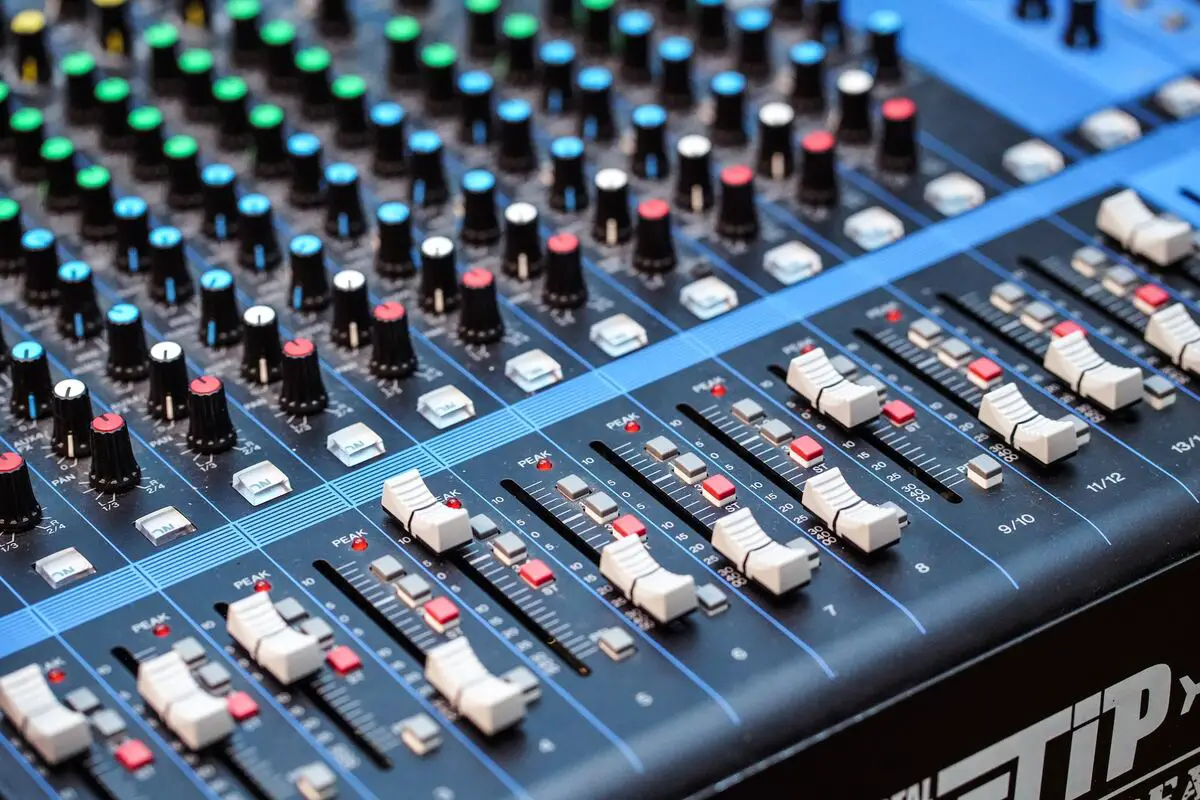Are you ready to elevate your audio mixing game? Whether you’re a newbie or a seasoned pro, there’s always something new to learn. In this post, we’ll explore aux sends in audio and show you how to take your sound to the next level.
If you’re feeling a little lost in the world of aux sends, don’t worry – we’ve got you covered. By the end of this post, you’ll be using aux sends to create reverb, delay, compression, and more with confidence. So let’s dive in and get started – it’s time to unleash the full potential of your sound!
What are aux sends in audio? Aux sends in audio are a way to route a portion of a track’s signal to a separate channel, allowing for the application of different effects. By using aux sends, you can create a more complex and dynamic sound while still maintaining clarity and balance in your mix. Aux sends are a powerful tool for any audio engineer or producer looking to take their sound to the next level.
How do aux sends work?
Aux sends are outputs on mixers that allow sound engineers to create an auxiliary mix, which can be sent to a separate destination such as a monitor, an effect processor, or a recording device. The sound signal from an input channel is sent to an aux send, where its level can be adjusted. This signal is then sent to the destination device and returned to the mixer using an aux return.

The sound can then be mixed with other signals in the mixer and sent to the main mix output. Different aux send controls for each channel allow for individual-level control. Aux sends can be used to share a single effect, such as reverb among multiple tracks, reducing the CPU load and helping to create a coherent sound. Some mixers feature multiple aux send knobs that allow users to send the FX return to any or all of the aux sends.
AKAI Professional MPK Mini MK3

AKAI Professional MPK Mini MK3
What is the difference between an aux send and an insert?
An insert effect is typically used for processors that change the whole signal, like EQ, compression, limiting, gates, etc., which will alter the signal of the entire track. Send effects, such as reverb, delay, and other time-based effects, are typically used to add effects to a signal without affecting the original audio.
The main difference between an aux send and an insert is the way they handle the signal flow and processing of an effect processor…
An insert slot interrupts the signal completely and routes it through the effect processor, and then returns the modified signal to the mix. On the other hand, an aux send is a separate independent output signal derived from one or more input channels on a mixing console, usually with the option to select a pre- or post-fader source and adjust the contribution level.
The main difference between an aux send and an insert is the way they handle the signal flow and processing of an effect processor, with inserts interrupting the signal completely and aux sends sending a copy of the signal to an auxiliary channel where effects are added without altering the original audio.
How do you use aux sends?
Aux sends are a versatile tool in audio engineering and have several different uses, including:
1. Setting up monitor mixes
Aux sends can be used to create separate monitor mixes for different performers on stage or in the studio, allowing them to hear themselves more clearly and adjust their performance accordingly.
2. Applying effects processing
Aux sends can be used to send audio signals to external effects processors, such as reverb or delay units, and then bring the processed signal back into the mixer via an aux return. This allows sound engineers to apply effects processing to multiple channels with a single processor and also to adjust the amount of processing on each channel individually.

3. Creating parallel processing chains
Aux sends can be used to create parallel processing chains, such as parallel compression or EQ, where a copy of the audio signal is sent to an aux track, processed separately, and then blended back in with the original signal. This technique can help to add depth, clarity, and character to audio recordings.
4. Routing signals to external recording devices
Aux sends can be used to route signals to external recording devices, allowing sound engineers to capture a separate mix for recording purposes without affecting the main mix. This can be useful for live recordings or when tracking in the studio.
5. Mixing different sources together
Aux sends can be used to mix different sources together, such as combining multiple drum mics into a single aux send for processing or blending together different instruments in a live performance. This allows sound engineers to have more control over the overall mix and balance of different elements.
Advantages and disadvantages of aux sends
Aux sends have various uses, including creating monitor mixes for performers and sending signals to effects processors during mixing. Here are the advantages and disadvantages of aux sends to help you understand their benefits and limitations.
Advantages
Aux sends offer several advantages that can enhance your sound mixing experience:
- Flexibility: Aux sends allow you to create separate mixes for different purposes, such as monitor mixes for performers or cue signals for speakers and headphones. This flexibility enables customized sound distribution according to specific needs.
- Individual Control: With aux sends, you have individual-level control over each input channel, independent of the main mix output. This allows you to fine-tune the balance and volume of each channel in the auxiliary mix, catering to the preferences of different performers or the requirements of specific effects.
- Effects Processing: Aux sends enable you to route signals to external effects processors. By sending specific channels to effects units like reverb or delay, you can enhance the sound with various creative effects, adding depth and ambiance to your mix.
Disadvantages
While aux sends provide valuable capabilities, they also have some limitations:
- Complexity: Utilizing aux sends effectively requires a good understanding of audio mixing concepts and equipment. Setting up multiple aux mixes and configuring different routing options can be intricate, especially for beginners. It may take time and practice to become proficient in using aux sends.
- Limited Availability: The number of available aux sends on a mixer may be limited. Depending on the model and size of your mixer, you might have a restricted number of aux sends, which can constrain the complexity and versatility of your mixes. It’s important to consider your specific mixing requirements when choosing a mixer with an appropriate number of aux sends.
Remember, despite these disadvantages, aux sends remain an indispensable tool for achieving optimal sound control and customization in live sound and recording scenarios. With practice and experience, the advantages of aux sends can outweigh any initial challenges.
How to set up aux sends
Setting up aux sends involves routing a copy of an audio signal to an auxiliary track or bus, allowing for the application of effects or the creation of a monitor mix. Here are the general steps:
- Determine which tracks need to be sent to the auxiliary channel.
- Set up an auxiliary track or bus in your DAW and assign it an available bus number.
- On the tracks that need to be sent to the auxiliary track, adjust the send level to the desired amount.
- Apply any desired effects or processing to the auxiliary track.
- Adjust the level of the auxiliary track in the mix to taste.
Additional information and specifics may vary depending on the mixing console or DAW being used. For example, some mixers may have separate aux sends for different monitors or external effects processors. It’s also possible to use aux sends to create parallel processing, such as parallel compression, by sending a copy of the signal to an auxiliary track and applying processing there before blending it back into the mix.
If you want even more tips and insights, watch this video called “What are Aux Sends?” from the Production Academy YouTube channel.
Conclusion
Well, there you have it, folks – the ins and outs of aux sends in audio mixing! I hope you’re feeling inspired to try out some new techniques and take your sound to the next level. Did I cover everything you wanted to know? If not, don’t hesitate to drop a comment below – I read and reply to each and every one.
And if you found this article helpful, be sure to share it with a friend who could use some audio mixing tips. And while you’re at it, check out my full blog for more insights on all things audio. Until next time, keep creating amazing sounds.
Key takeaways
This article covered aux sends. Here are some key takeaways:
- Aux sends in audio are a way to route a portion of a track’s signal to a separate channel, allowing for the application of different effects.
- By using aux sends, you can create a more complex and dynamic sound while still maintaining clarity and balance in your mix.
- Setting up aux sends will vary depending on your specific DAW but typically involves creating a new aux track, assigning the desired effect, and then sending the desired amount of signal from your original track to the aux track.
- Aux sends can be used for applying effects like reverb or delay, as well as for parallel compression to achieve a thicker, more impactful sound.















